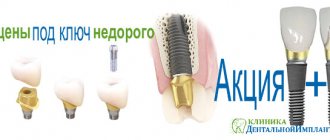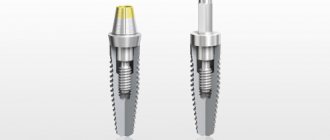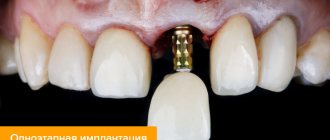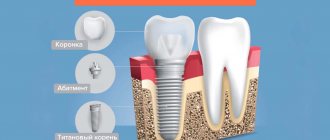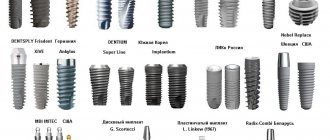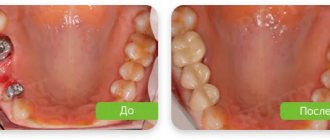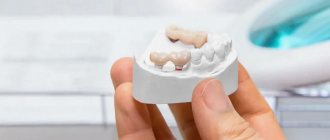The term “abutment” comes from the English word “abutment” (translated as “support” or “secondary part of the implant”). Indeed, the abutment
installed on
the implant
- and it functions as a link that connects it to the prosthesis. Despite the fact that abutments can be different, one end of them is screwed onto an already installed implant, and the other serves as a support on which the dentist places the prosthesis.
Although many implant manufacturers strive to produce one-piece designs in which the endosseous portion is integrated with the apex, avoiding the need for an abutment
, complete abandonment of them is not yet possible. It is thanks to them that maximum aesthetics is achieved, which makes them indispensable for dental prosthetics in the smile area.
Consultation with an orthopedist—RUB 1,000.
Individual abutment made of zirconium oxide - RUB 32,000.
At CELT you can get advice from a dental specialist.
- The cost of an orthopedic consultation is 1,000
Make an appointment
Types of abutments, their features
| Abutment type | Advantages | Flaws |
| Standard - is a design made in accordance with a template, available in different lengths and angles of the upper cone. |
|
|
| An individual abutment is made taking into account the anatomical characteristics of the patient in accordance with the three-dimensional model of his jaw. |
|
|
In addition, based on the design and application features, the following types of abutments for implants
:
| Type of design | Peculiarities |
| Globular | It has a round shape and is intended for mini-implantation using removable prostheses. Allows you to quickly and easily carry out prosthetics, but is not able to provide a uniform load on the implants and wears out quickly. |
| Angular | It has a design in which the head can be tilted from 15° to 45° in 10° increments. Designed for use with implants installed at an angle due to anatomical features. |
| Straight | It is considered the most practical and is widely used in cases where the entire structure has a straight line. As a rule, it is used to restore front teeth. |
| Whole | It is one piece with the implant. It is the best option for implantation under a one-stage protocol with immediate loading. |
| Temporary | It is a design for forming a beautiful gum relief around the implant and prosthesis. Installed during the implant healing period and removed after that. |
Structural features of abutments
Previously, in dentistry, an abutment meant a special structure that supported a bridge.
Now this term has acquired a completely different meaning; in translation from English the word abutment is translated as “support”. It looks like a small part, it comes in different shapes, lengths, diameters, which model is right for you depends on the clinical case. If the dentist installs an abutment that does not correspond to the characteristics of the implant, then such a tooth will not be able to last long. Ultimately, the crown may simply fall out. Therefore, you should carefully choose the clinic where the operation will be performed and the implantologist. When it has become a little clearer what this element is, we can begin to explain its characteristics.
- Depending on the chosen implant, there are a huge variety of types of abutments. They differ from each other in material, type of fastening, diameter, size, angle of inclination, etc. The integrity of the entire structure depends on the correct selection of the connecting element.
- Although the abutment comes in different types, it is fixed to the implant in the same way in all cases. One end of it is fixed to a titanium root, and a crown is installed on the other.
- Abutments can be factory-fabricated, standardized in size, and mass-produced. Such designs have an affordable price, so they are in demand among patients. You can also order the production of abutments, taking into account your individual jaw characteristics. Experts recommend not saving on this element.
Many patients wonder why it is necessary to install an abutment after implantation, and whether it is possible to do without it. Our answer is of course not, the use of this element is mandatory when performing implantation. The implant acts as the root of the tooth, it supports the entire orthopedic structure, the crown is the visible part of this system, it is located above the gum. And the abutment is the binder that ensures a smooth transition from the titanium root to the prosthesis.
Implantation can be carried out using two methods; when immediate tooth restoration is required, simultaneous implantation is recommended. Urgent help from an implantologist may be needed if you lose the front teeth included in the smile area. In this case, the abutment is already connected to the implant and looks like a complete structure. Two-stage technology requires more time after
The implant will be installed; it will take several months for it to take root. When it has successfully osseointegrated into the bone, the gum is again incised, the plug is removed and an abutment is fixed in its place.
The patient can buy the abutment at any dentistry that provides implantation services. But usually when carrying out this procedure, the clinic provides all the necessary elements.
The doctor decides which abutment to install; he must take into account the patient’s preferences, his aesthetic wishes, the thickness of the mucous membrane, and what type of fixation will be used. A specialist should accurately evaluate all of the listed factors and select the appropriate element.
Manufacturing materials
In the process of studying the material about what implant abutments are, you will definitely come across information about the materials from which they are made. And this is no coincidence: the functionality and aesthetic result of further prosthetics depends on what material is used.
| Materials for production | Abutment Features |
| Plastic | They have the lowest price; due to their lack of strength, they are used as a temporary measure during the formation of gingival implants during the healing process. |
| Titanium | They have an optimal price-quality ratio, are durable and reliable, but cannot always be used to restore teeth in the smile area, since they are visible through the crown. |
| Ceramics | They are used if the patient suffers from individual intolerance to metal elements; they are ideal for restoring front teeth. |
| Zirconium dioxide | They are the most expensive, especially when made individually. Capable of providing a durable solution, very durable and aesthetically pleasing. |
| Combined (titanium-zirconium alloys) | Quite expensive, but they provide excellent restoration results: both in terms of functionality and aesthetics. |
Kinds
As already mentioned, all abutments can be divided into individual and standard.
Standard systems are universal and are manufactured according to specific templates. Their advantages: a variety of models, it is not difficult to choose a suitable design, if necessary, you can easily replace it by choosing another connecting element. Standard abutment, the price is not high, affordable for most patients. Products made to order, taking into account the anatomical features of the human jaw, are more expensive than factory ones, but at the same time they are not inferior, and even surpass them in quality and technical characteristics. Individual designs are created using modern CAD/CAM technology, which means that the abutment will accurately match the implant, eliminating possible errors and complications. Zirconium is mainly used to create this type of system. It is characterized by high strength and excellent aesthetic characteristics.
Based on functionality, it is customary to distinguish the following types of abutments:
Angular.
Such structures can be installed at a certain angle; the tilt allows you to give a natural look to the implantation system.
Globular.
Designed for fixation on mini-implants, it can also be used for removable prosthetics.
Straight.
Suitable for restoring anterior groups of teeth, because... in this case, the implant structure should be fixed directly.
Temporary (gum former).
This type of abutment is used to create the desired soft tissue relief around an artificial tooth. The gum former is not installed on a permanent basis; it is removed after 10-14 days, as soon as it has fulfilled its main function.
The price of an implant abutment depends not only on the characteristics of its type, but also on what material it is made of. This factor has a huge impact not only on cost, but also on the aesthetic result.
Titanium.
A universal material used to create not only abutments, but also implants. It is distinguished by strength, reliability, wear resistance and, of course, high biocompatibility with the human body. Titanium systems are suitable for restoring molars because... They can withstand loads very well. The only drawback of this material is that it can shine through the crown, which is why it is not recommended for reconstruction of the anterior groups of teeth.
Zirconium.
Due to its high cost, zirconium dioxide is often ignored by patients, but this material has good characteristics. Firstly, it does not show through the prosthesis, secondly, it has increased strength, and thirdly, it does not cause allergies.
Combined.
This type of abutment involves a combination of several types of materials, such as titanium and zirconium. Such structures are extremely durable and highly aesthetic, but they are also expensive.
Plastic.
Plastic attracts with its availability, and this is its only advantage. Often, plastic abutments are used only for temporary purposes, as a gum former.
Features of abutment installation
The procedure for installing an abutment is quite complex, since it requires not only screwing it in, but also reliable fixation. If the abutment is not installed correctly, the crown will become loose and eventually fall out. In order to achieve the desired result, two types of fixation methods are used:
- Screw - requires making a small hole in the crown through which the abutment screw is passed. The crown is screwed on, after which the hole is masked with special materials and fixed. The risk of breaking the crown with such fixation is higher, but the risk of developing inflammatory processes is lower, and the fixation itself is quite reliable;
- Using dental cement - does not require drilling a hole in the prosthesis, fixation is carried out using cement. It is used in cases where screwing is not possible, since the risk of damage to the crown is high and the aesthetic characteristics deteriorate.
Where to make?
If you need to undergo implantation and select an abutment in Moscow
, contact the multidisciplinary clinic CELT. The specialists of our dental department carry out individual selection of abutments, taking into account a number of aspects:
- the patient's wishes regarding appearance;
- thickness of the mucous membrane;
- type of prosthesis fixation;
- the gap between adjacent teeth and the head of the implant.
Thanks to a balanced assessment of all the above factors, the selection of the abutment is carried out correctly: it forms a clear gum line and is a reliable support for soft tissues. All this minimizes the possibility of cement penetration under the gum and ensures long-term results! Contact us!
Prices
Abutment installation price depends on a number of factors, as already mentioned, there are different varieties of this element, the characteristics of the model will determine the final cost of the structure. Typically, all these issues are discussed at a doctor's appointment, when a treatment plan is being drawn up. At the A-medic clinic, specialists perform dental implantation using standard and individual systems. You can find out more detailed information about how much an implant abutment costs by calling: +7 (499) 350-44-47.
Reviews of doctors providing the service - Abutment
I would like to express my gratitude to the dentist Elena Nikolaevna Kiseleva and her assistant Svetlana - they are real specialists and at the same time sensitive, not burnt out by years of practice.
Thanks to them, I have been coming back here for many years. Thanks to the management for such doctors! Read full review Svetlana Nikolaevna
13.08.2021
I am very grateful to Evgeniy Borisovich Antiukhin for removing my three eights. Especially considering that the lower tooth was not the simplest (it was located in an embrace with a nerve). The removal took place in 2 stages, one tooth under local anesthesia, two under general anesthesia. I had no idea that wisdom teeth could be... Read full review
Sofia
28.12.2020
